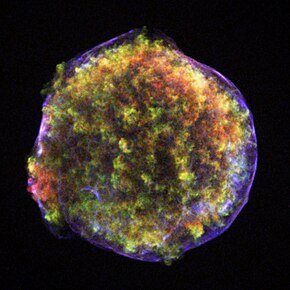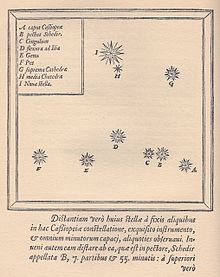
A supernova is a powerful and luminous explosion of a star. A supernova occurs during the last evolutionary stages of a massive star or when a white dwarf is triggered into runaway nuclear fusion. The original object, called the progenitor, either collapses to a neutron star or black hole, or is completely destroyed to form a diffuse nebula. The peak optical luminosity of a supernova can be comparable to that of an entire galaxy before fading over several weeks or months.
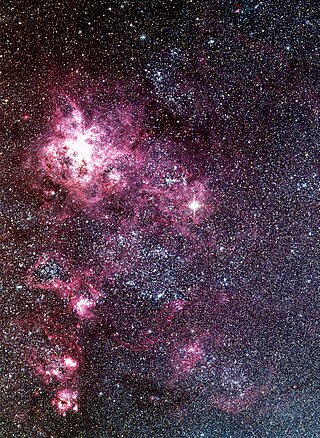
SN 1987A was a type II supernova in the Large Magellanic Cloud, a dwarf satellite galaxy of the Milky Way. It occurred approximately 51.4 kiloparsecs from Earth and was the closest observed supernova since Kepler's Supernova. 1987A's light reached Earth on February 23, 1987, and as the earliest supernova discovered that year, was labeled "1987A". Its brightness peaked in May of that year, with an apparent magnitude of about 3.

SN 1604, also known as Kepler's Supernova, Kepler's Nova or Kepler's Star, was a Type Ia supernova that occurred in the Milky Way, in the constellation Ophiuchus. Appearing in 1604, it is the most recent supernova in the Milky Way galaxy to have been unquestionably observed by the naked eye, occurring no farther than 6 kiloparsecs from Earth. Before the adoption of the current naming system for supernovae, it was named for Johannes Kepler, the German Astronomer who described it in De Stella Nova.

A supernova remnant (SNR) is the structure resulting from the explosion of a star in a supernova. The supernova remnant is bounded by an expanding shock wave, and consists of ejected material expanding from the explosion, and the interstellar material it sweeps up and shocks along the way.
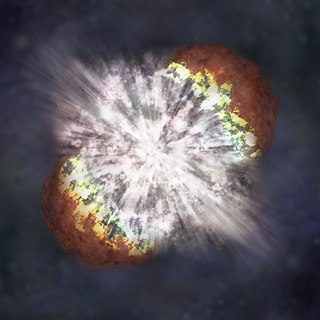
A super-luminous supernova is a type of stellar explosion with a luminosity 10 or more times higher than that of standard supernovae. Like supernovae, SLSNe seem to be produced by several mechanisms, which is readily revealed by their light-curves and spectra. There are multiple models for what conditions may produce an SLSN, including core collapse in particularly massive stars, millisecond magnetars, interaction with circumstellar material, or pair-instability supernovae.

3C 58 or 3C58 is a pulsar and supernova remnant within the Milky Way. The object is listed as No. 58 in the Third Cambridge Catalogue of Radio Sources.

First observed between August 4 and August 6, 1181, Chinese and Japanese astronomers recorded the supernova now known as SN 1181 in eight separate texts. One of only five supernovae in the Milky Way confidently identified in pre-telescopic records, it appeared in the constellation Cassiopeia and was visible and motionless against the fixed stars for 185 days. F. R. Stephenson first recognized that the 1181 AD "guest star" must be a supernova, because such a bright transient that lasts for 185 days and does not move in the sky can only be a galactic supernova.
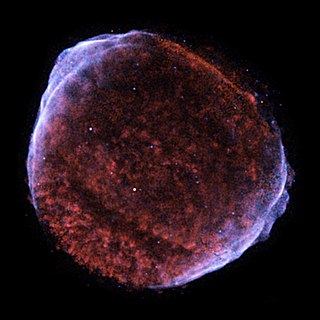
SN 1006 was a supernova that is likely the brightest observed stellar event in recorded history, reaching an estimated −7.5 visual magnitude, and exceeding roughly sixteen times the brightness of Venus. Appearing between April 30 and May 1, 1006, in the constellation of Lupus, this "guest star" was described by observers across China, Japan, modern-day Iraq, Egypt, and Europe, and was possibly recorded in North American petroglyphs. Some reports state it was clearly visible in the daytime. Modern astronomers now consider its distance from Earth to be about 7,200 light-years or 2,200 parsecs.

A Type Ia supernova is a type of supernova that occurs in binary systems in which one of the stars is a white dwarf. The other star can be anything from a giant star to an even smaller white dwarf.

SN 185 was a transient astronomical event observed in the year AD 185, likely a supernova. The transient occurred in the direction of Alpha Centauri, between the constellations Circinus and Centaurus, centered at RA 14h 43m Dec −62° 30′, in Circinus. This "guest star" was observed by Chinese astronomers in the Book of Later Han (后汉书), and might have been recorded in Roman literature. It remained visible in the night sky for eight months. This is believed to be the first supernova for which records exist.

The known history of supernova observation goes back to 1006 AD. All earlier proposals for supernova observations are speculations with many alternatives.

Type Ib and Type Ic supernovae are categories of supernovae that are caused by the stellar core collapse of massive stars. These stars have shed or been stripped of their outer envelope of hydrogen, and, when compared to the spectrum of Type Ia supernovae, they lack the absorption line of silicon. Compared to Type Ib, Type Ic supernovae are hypothesized to have lost more of their initial envelope, including most of their helium. The two types are usually referred to as stripped core-collapse supernovae.

A light echo is a physical phenomenon caused by light reflected off surfaces distant from the source, and arriving at the observer with a delay relative to this distance. The phenomenon is analogous to an echo of sound, but due to the much faster speed of light, it mostly only manifests itself over astronomical distances.

Tycho G has been proposed as the surviving binary companion star of the SN 1572 supernova event. The star is located about 6,400±1,500 light-years away in the constellation Cassiopeia. It is a subgiant, similar to the Sun in temperature, but more evolved and luminous.

Pilar Ruiz-Lapuente is an astrophysicist working as a professor at the University of Barcelona. Her work has included research on type Ia supernovae. In 2004, she led the team that searched for the companion star to the white dwarf that became supernova SN 1572, observed by Tycho Brahe, among others. Ruiz-Lapuente's research on supernovae contributed to the discovery of the accelerating expansion of the universe.

SN 1895B was a supernova event in the irregular dwarf galaxy NGC 5253, positioned 16″ east and 23″ north of the galactic center. It is among the closest known extragalactic supernova events. The supernova was discovered by Williamina Fleming on December 12, 1895 after noticing an unusual spectrum on a photographic plate taken July 18, 1895, and was initially given the variable star designation Z Centauri. The light curve is consistent with an event that began ~15 days before the discovery plate was taken, and this indicates the supernova reached a peak visual magnitude of up to 8.49±0.03.

A hypernova is a very energetic supernova which is believed to result from an extreme core-collapse scenario. In this case, a massive star collapses to form a rotating black hole emitting twin astrophysical jets and surrounded by an accretion disk. It is a type of stellar explosion that ejects material with an unusually high kinetic energy, an order of magnitude higher than most supernovae, with a luminosity at least 10 times greater. They usually appear similar to a type Ic supernova, but with unusually broad spectral lines indicating an extremely high expansion velocity. Hypernovae are one of the mechanisms for producing long gamma ray bursts (GRBs), which range from 2 seconds to over a minute in duration. They have also been referred to as superluminous supernovae, though that classification also includes other types of extremely luminous stellar explosions that have different origins.

NGC 4424 is a spiral galaxy located in the equatorial constellation of Virgo. It was discovered February 27, 1865 by German astronomer Heinrich Louis d'Arrest. This galaxy is located at a distance of 13.5 million light years and is receding with a heliocentric radial velocity of 442 km/s. It has a morphological class of SB(s)a, which normally indicates a spiral galaxy with a barred structure (SB), no inner ring feature (s), and tightly-wound spiral arms (a). The galactic plane is inclined at an angle of 62° to the line of sight from the Earth. It is a likely member of the Virgo Cluster of galaxies.
Ken'ichi Nomoto is a Japanese astrophysicist and astronomer, known for his research on stellar evolution, supernovae, and the origin of heavy elements.
